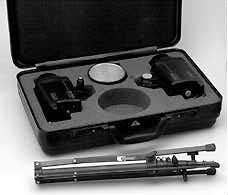
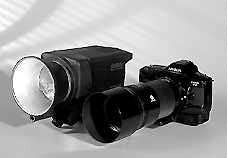 BACK IN the early 1980s a very small and cleverly designed modular mains or
battery flash unit called the Profilite was launched by Multiblitz. Its
efficiency in terms of light output was legendary, enhanced by a brilliant
12V 50W modelling bulb and a parabolic reflector which created a precise
circle of totally even illumination.
BACK IN the early 1980s a very small and cleverly designed modular mains or
battery flash unit called the Profilite was launched by Multiblitz. Its
efficiency in terms of light output was legendary, enhanced by a brilliant
12V 50W modelling bulb and a parabolic reflector which created a precise
circle of totally even illumination.
Most photographers never bought the 12V shoulder battery pack or the automobile adaptor - they used the Profilite as a mains flash only. The fact that it had a tendency to melt with prolonged use didn't bother many people as the damage was purely cosmetic. It was the first plastic-bodied studio flash, and many have followed, the ventilation and insulation of the body gradually improving.
Now the Profilite's small size and efficient performance has been revived, fifteen years later, with the slightly more powerful non-modular, AC-supply only Profilite Compact 200. With a Watt-seconds output matching its name, this unit is scarcely bigger than an outstretched hand at 95mm 'square' and 240mm long. I first saw it at photokina in September 1994, and when Hasselblad (UK) Limited took over Multiblitz distribution in Britain I requested a Set-400 kit to review.
"It is a kit", said Andy. "There's probably just one head inside the case, though - it weighs nothing at all."
We opened the case. There were two heads in there.
"That�s incredible", I remarked. "I honestly thought the parcel just had one head in it. I had no idea there was a fitted case with two heads. But they've only sent one reflector."
So, thinking we had just a couple of heads and only one spill-kill reflector, we left the case hanging around and got on with work. Then the time came to open it up, test the units and photograph them. Richard was in the studio, setting up the picture of the Minolta 9xi next to the Profilite to shoot on our Lumina digital studio camera. He had not handled the flash before and was just as surprised as I was at the non-existent weight.
I asked him to photograph the case open. A couple of minutes later he asked whether I wanted all the stuff in the lid showing, or just the heads in the bottom part. �What stuff in the lid?� I asked...

In the top of this tiny suitcase-style kit were all the power leads, synch cables, a complete half-metre square soft box and an umbrella. Now I realised why we had just one reflector - that was for use with the silvered brolly. The other head was to go with the softbox.
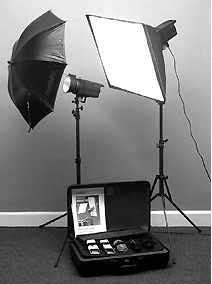
We put it all together, adding a couple of miniature Multiblitz five-section stands which I had saved from the days when I owned the original Profilite; these will actually fit inside the case lid, too. Here, in a kit little larger than an attach� case, was a complete two-head studio. The lightproofing of the softbox and the black vinyl backing of the brolly combined with the hard, sharp focusing of the small fat flashtubes and glass-domed peanut halogen bulbs to create absolute, 100% use of available light.
The stand fitting and head angle adjustment is extremely compact, so that everyone agreed it was rather difficult to attach and adjust the heads. The clever locking arm for the mains cable prevents the head from being angled upwards fully.
The flash lead supplied was coiled; a straight one would be less trouble. It is a small jack plug type, no easy to obtain in a hurry if one is damaged.
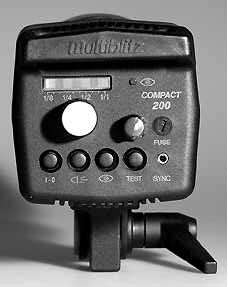
The controls of the new Profilite are, in contrast, wonderful. It's all at the back; switchable slave cell, proportional modelling on or off, and a brilliant power variator knob which not only goes down to an unbelievable 1/8th power but displays this in third-stop increments on an illuminated LED array.
The big grab handle at the back makes carrying or resetting a single head easy. The four-claw bayonet reflector fitting is excellent, and there�s a space in the case for one of the highly efficient parabolics, but in removing the softbox Richard nudged the flashtube, as the action is stiff and there is little clearance. Care is needed. No damage was done.
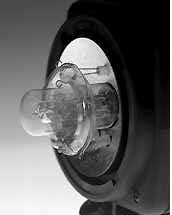
The brolly fitting is external, in a tube on the spill-kill reflector, and thus keeps the pole away from the tube. The modelling lamp is not exposed, as on earlier models, but encased in a neat miniature pyrex dome for safety (this is a feature of the bulb, a 230V 60W Osram 64862 E14 screw fit). Why not encase the entire tube and use a cheaper peanut modelling lamp instead?
An Minolta Flashmeter IV incident light reading was taken with both units bounced off a ceiling in controlled conditions. This read f8.0.8 for the Prolinca 400; the Profilite 200 read f5.6.8, exactly one stop less, and this identically efficient.
The small COMSCH reflector supplied proved more efficient than the Prolinca equivalent. Direct readings at 3.5m distance were f8.0.8 again for the Prolinca, but f8.0.2 for the Profilite.
Recycling was stated to be 1.7 seconds maximum, but there is no pre-charge firing cut out. The lamp array glows dim as the charge takes place, bright when full charge is reached. It was possible to fire rapidly at full power before this happened; the result was a variable low output.
At minimum power, a time of 0.7 seconds is given. In practice, a 2 fps motor drive could be used without significant exposure variation on both our test heads. There would be no problem with a motorised Hasselblad or Mamiya at powers up to half.
The infra-red slave cell proved capable of triggering in room conditions using Wein or Bowens IR triggers, as well as any other flash. The flash durations, stated at 1/400 to 1/800 T0.5, are not especially short but are ideal for general portrait work where very short times may cause loss of optimum quality on colour negative films.
There is a comrehensive range of further accessories, always a strong point from Multiblitz; honeycombs, snoots, background uplighter, capped reflector, rigid hazylight, barn doors, filters and more.
We can recommend the Multiblitz Profilite Compact 200 Set-400 as an ideal location kit for up-market portraiture of individuals up to three-quarter length, couples, and small groups. It is also excellent for close-ups, location food shots, and macro work - and for anyone who enjoys the idea of a kit based on flash heads weighing only 1200 grams each and a kit you could carry all day without even noticing.